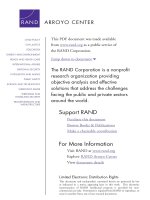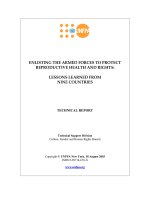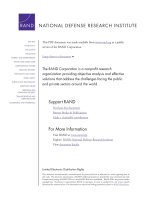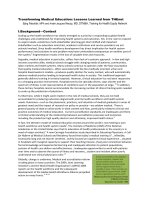Lessons Learned from the Field: Where do we go from here? docx
Bạn đang xem bản rút gọn của tài liệu. Xem và tải ngay bản đầy đủ của tài liệu tại đây (198.18 KB, 77 trang )
Reproductive Tract Infection
Lessons Learned from the Field:
Where do we go from here?
Report of a seminar presented
under the auspices of the Population Council's
Robert H. Ebert Program on Critical Issues
in Reproductive Health and Population
February 6–7, 1995
New York, New York
Editorial Assistance
Jennifer Grant, M.A.
Diana M. Measham, MSc.
The Population Council
The Robert H. Ebert Program on Critical Issues
in Reproductive Health and Population
One Dag Hammarskjold Plaza
New York, NY 10017 USA
Telephone (212) 339–0500
Fax (212) 755-6052
Published March 1996
Cover and text printed on recycled paper in the USA
ACKNOWLEDGMENTS
We are grateful to the Ford Foundation for generous support of the seminar and
production of this publication, and to the Rockefeller Foundation for support of the
seminar. In addition, some seminar participants were supported with USAID and
SIDA funds. We also thank Virginia Kallianes for assistance in preparing this
document.
ABBREVIATIONS
AIDS Acquired immune deficiency syndrome
ELISA Enzyme-linked immunoassay
GC Gonococcus (organism that causes Gonorrhea)
KOH Potassium hydroxide
HIV Human immunodeficiency virus
IUD Intrauterine device
LCR Ligase chain reaction
LED Leukocyte esterase dipstick
PCR Polymerase chain reaction
PID Pelvic inflammatory disease
RPR Rapid plasma reagin
RTI Reproductive tract infection
STD Sexually transmitted disease
TPHA Treponema pallidum (syphilis) hemagglutination assay (for antibodies)
VDRL Venereal Disease Research Laboratory
TABLE OF CONTENTS
EXECUTIVE SUMMARY i
INTRODUCTION AND OVERVIEW
Beverly Winikoff 1
Christopher Elias 4
UPDATE ON STD DIAGNOSIS
William M. McCormack 8
Commentary: Vilma Barahona 10
DEFINING THE SCOPE OF RTI
S
: QUANTITATIVE RESEARCH
Kathryn Tolbert 12
Eugenio Pacelli de Barreto Teles 15
Joan Kaufman 17
INDIVIDUAL PERCEPTIONS: QUALITATIVE RTI RESEARCH
Huda Zurayk 20
Adepeju Olukoya 21
Nandini Oomman 22
THE UTILITY OF ALGORITHMS AND RISK SCREENING
Earmporn Thongkrajai 25
Discussants: Huda Zurayk 30
Inne Susanti 32
BUILDING THE COALITIONS NEEDED TO ADDRESS RTI
S
:
SERVICE PROVIDERS, POLICYMAKERS, COMMUNITIES
Nguyen Kim Cuc 34
Inne Susanti 35
Nicola Jones 36
IMPACT ASSESSMENT: WHAT CRITERIA DO WE USE TO DEMONSTRATE THE
IMPORTANCE OF RTI
S
TO POLICYMAKERS?
Ana Langer 39
Valerie Hull 46
Joan Kaufman 47
LESSONS LEARNED FROM RESEARCH ON RTI
S
:
SUMMARIZING THE OBSTACLES ENCOUNTERED
Valerie Hull 49
Esther Muia 53
Nandini Oomman 54
DEFINING THE RANGE OF FUTURE RESEARCH PRIORITIES AND
INTERVENTIONS
Earmporn Thongkrajai 56
Adepeju Olukoya 57
CLOSING SUMMARY
Beverly Winikoff and Christopher Elias 58
APPENDIX 61
PARTICIPANT LIST 62
i
EXECUTIVE SUMMARY
Introduction and Overview
Interest in Reproductive tract infections (RTIs) has increased enormously, and
enthusiasm to act is palpable. A great deal of work must be done, however, before we will be in a
position to respond adequately to the problem. As a result, the Population Council convened a
meeting to examine how best to use available tools and information, learn about potential service
delivery approaches, and examine the direction of research. The meeting began with an
examination of what is known about the prevalence, distribution, determinants, characteristics,
and consequences of RTIs, as well as the common elements of an intervention framework. The
group then moved on to examine and discuss a range of key topics, as summarized below.
There are five basic approaches to diagnosing RTIs. These were discussed in terms of
their utility for diagnosing chlamydia, gonorrhea, genital ulcers, syphilis, herpes, chancroid, human
papilloma virus (HPV), trichomoniasis, candidiasis, and bacterial vaginosis (BV).
Quantitative research conducted in Mexico, Brazil, and China was presented. The
Mexico study, for example, found higher levels of RTIs than expected among women in both
hospital and community samples. Chlamydia rates among women in the hospital sample were
found to be as high as those found in a study of commercial sex workers in Mexico.
Qualitative research conducted in Egypt (Giza), Nigeria (Lagos), and India (Rajasthan)
was presented. The Rajasthan study, for example, focused on
dhola Pani
, the local term for white
discharge, in an effort to develop an ethnomedical model of this problem. Among other things,
women believe that poverty leads to physiological weakness, which in turn results in discharge.
Because they view the root cause of the problem as an economic one, they do not seek health
care.
Research on the utility of algorithms and risk screening in Khon Kaen province, Thailand
and Giza, Egypt was presented. In both cases, the risk factors investigated were found not to
correspond with clinical data, and, therefore, not to be predictive for RTIs. In Giza, for example, a
number of methods were used to determine the extent to which reports or observations of
symptoms, compared to medical examinations, could provide an estimate of RTI prevalence. It
was found that the presence of discharge—regardless of who reported it and whether or not it was
considered medically suspicious—was not predictive for RTIs.
Information presented on Vietnam and Bali, Indonesia made it clear that there is an
urgent need to develop multi-sectoral, interdisciplinary coalitions to overcome the obstacles to
effective RTI management. There are, however, many obstacles to effective coalition building. In
order to overcome some of these obstacles, the Ford Foundation in the Philippines is supporting
programs to bring activists from a wide range of backgrounds together to work on RTIs.
In spite of increasing consensus regarding the importance of addressing sexually
transmitted (STDs) and merging vertical programs and services, numerous questions arise when
it comes to investing resources in this area. Is it really necessary? Are STD programs cost-
effective? Can the impact of STD-related activities be measured? Is it feasible to implement all
the services necessary to ensure that an STD program is effective? Each of these questions was
addressed based on the outcomes of related research, which, it was noted, has yet to provide
sufficient information to overcome the skepticism. There is an urgent need to conduct further
research and to provide the skeptics with clear and precise information on the direct and indirect
ii
consequences of RTIs, and to illustrate the possibilities for integrating RTI interventions with
existing programs.
General obstacles related to work in the area of RTIs include lack of awareness of the
problem and the limited power of women in society. Obstacles to developing research include
difficulties in setting local priorities due to lack of dialogue with or input from the community and a
lack of alliances between researchers and service providers. Proposals for overcoming some of
these obstacles were presented, as were the specific obstacles confronted by RTI research
conducted in Rajasthan, India and Kenya.
Priorities for future research and programming included: further research on the scope
and consequences of RTIs; integration of RTI services with other types of health care; continued
investment in female-controlled technology; research on gender and power relations and their
relationship to STDs and related protective measures; and research on appropriate low-cost
diagnostics and screening tools.
There was broad agreement among participants that candida, BV, and trichomonas are
the most widespread infections. These infections are relatively easy to deal with, but are not the
most serious. This poses a difficult question: what does one do when the infections that are
easiest to treat pose the least serious health problems? There was also broad agreement that
providers must be able to diagnose and treat RTIs in order to provide contraceptive services of an
acceptable quality.
The group heard a great deal about the complex issues surrounding RTIs. While more
questions were raised than conclusions reached, the meeting helped to facilitate a move forward
in dealing with this serious public health problem.
1
INTRODUCTION AND OVERVIEW
Beverly Winikoff
The Population Council
New York, New York
As the title of this meeting implies, we did not gather to discuss a finished product, but
neither are we just beginning to look at the issues surrounding reproductive tract infections (RTIs).
These issues are so complex that we did not want to wait for the all of the research that is
underway to be completed prior to examining the direction of our work in this area. The timing of
this meeting is particularly apt: interest in RTIs is becoming widespread and enthusiasm to do
something about the problem—and to do something soon—is palpable. There is, however, much
more work to be done before we will know how to respond adequately to the problem.
From its inception, the Population Council's Robert H. Ebert Program on Critical Issues in
Reproductive Health and Population has been interested in the subject of RTIs and sexually
transmitted diseases (STDs). The Program was established in 1988 to bring attention to serious
and understudied—and often controversial—issues affecting reproductive health. The subject of
RTIs is clearly relevant to the program's mandate for several reasons, including the following:
The problem is enormous The World Health Organization (WHO) estimates that 100
million acts of intercourse take place daily and that these result in the transmission of an
estimated 356,000 sexually transmitted infections per day.
The problem is poorly defined Until recently, there has been very little qualitative or
quantitative research on the extent and dimensions of the problem.
The problem relates to the provision of contraceptive services It is highly relevant to the
Population Council and other sister institutions working in the field of family planning and repro-
ductive health.
The problem is controversial Concerns aroused by discussions of RTIs, and especially
of STDs, are emblematic of gender and power inequities, subjects which generate controversy.
At the same time, and more urgently, a number of different forces have focused interest
on RTIs. Several well-publicized studies have demonstrated that levels of infections are alarm-
ingly high, surprising both women's health advocates and the public health community. The
increased focus on
quality of care
in family planning also brought attention to RTIs, reminding us
of issues surrounding a health care provider's ability to diagnose infections in family planning cli-
ents, appropriate use of IUDs, and the risk to a client of iatrogenic infections. The fact that STDs
are a known co-factor in AIDS transmission has also focused attention on the topic. Finally, over
2
the months since the International Conference on Population and Development (ICPD) held in
Cairo in September 1995, there has been accelerating interest in the idea of
reproductive health
.
Nonetheless, while there is strong impetus to develop strategies to deal with RTIs, there
are great obstacles to doing so. Related services are expensive and difficult to provide. They
require a range of diagnostic tests and equipment, specific and complicated training, and drugs
that may not normally be available in a clinic setting. In addition, clinics would have to deal with
the complex issues of partner identification, notification, and treatment. We also lack the techni-
cal tools for treatment, screening, and diagnosis of RTIs in resource-constrained environments. A
further impediment to addressing RTIs is that these services are currently orphan services. Pro-
viders fear that existing services will be stigmatized if RTI treatment is offered alongside family
planning services, for example, because RTIs are associated with STDs, even when they are not
sexually transmitted. An increased focus on RTIs can also be threatening to providers of IUDs
and hormonal contraceptives that do not protect against sexually transmitted infections (oral
contraceptives, NORPLANT
®
implants, Depo Provera). The most significant obstacle to
addressing RTIs is the implied social critique that accompanies the issue of RTIs and the gender
power questions this problem raises. Such questions, some of which are noted below, may
threaten traditional political and social structures.
· Should men shoulder the blame for women's health?
· Is it fair—or is now the time—to examine traditional male behavior and make
normative judgements or propose change?
· Is there a need to make men do things they might not otherwise choose to do,
including using condoms?
The issue of RTIs raises questions regarding widely-held assumptions about sexuality.
Not surprisingly, talking about sexual encounters makes people uncomfortable. The data
available indicate, however, that often, sexual encounters are not voluntary, pleasurable, or safe
for women, who may lack control over the number of partners they have, the timing of sexual ac-
tivity, men's behavior, and contraceptive use. Confronting the problem of RTIs requires facing
these troubling issues.
Despite the difficulties outlined above, we have begun to study RTIs in both quantitative
and qualitative ways, as the agenda of this meeting indicates. We have tried to determine if it is
important to quantify the extent of the problem, and, if so, among which groups? The general
population? Particular regions? We have also examined the utility of community and individual
perceptions gathered through qualitative research. Whose perceptions are we interested in?
3
Women's? Men's? Special groups'? Special regions'? How can we best use the information
gathered through both qualitative and quantitative research? For program planning? For political
ends? For advocacy? To improve research?
We are also looking very carefully at various prevention strategies. While we have some
guideposts, we do not yet have a clear road map on this issue. There are numerous areas that
demand further exploration, including: the role of information, education, and counseling; quality
of care and provider practices; the extent to which condom promotion is a realistic prevention
strategy; and the extent to which women's empowerment—including access to resources, legal
rights, and their ability to make choices and participate equally in the nature of and
decisionmaking regarding their relationships with men—can be seen as a prevention strategy.
We also need to examine treatment as a prevention strategy, in that it protects the individual and
the community and may prevent other diseases, such as AIDS. We face a major dilemma in this
area, and must determine who should be treated, and when they should receive treatment. We
must also examine community and individual definitions of illness, and the role of these definitions
in the development of prevention and treatment strategies.
There are a few things that we can say with confidence. We know that there exists
widespread incidence of RTIs and that the specific patterns of these infections vary: some are
STDs, some are not; and some are more serious than others. We know that we disagree on the
infections that merit the most focus, and why. There is also a lack of understanding among
women about the etiology, seriousness, and range of infections. In addition, clinicians lack an
understanding of the problem and do not have the ability to provide appropriate information or
detect cases. Finally, we know that we have little or no information on program approaches and
that we are unable to give clear advice to policymakers and program managers.
As we convene this gathering to discuss this complicated issue, we hope to:
· examine how to use the tools and information available from quantitative and
qualitative research in both advocacy and program planning;
· learn about the approaches to service delivery that may be most fruitful; and
· examine whether we should change our direction and/or the type of the research
we are conducting on this topic.
In some ways, this meeting is part of an ongoing internal discussion. The agenda
focuses on a number of collaborative projects in which the Council has participated, although
others will also be discussed. We hope that by sharing our results and thinking to date we will
help others who also struggle with these issues, and we are sure that your contributions will help
4
us immeasurably as we move forward with our own work on RTIs.
Christopher Elias
The Population Council
Bangkok, Thailand
While there are many unanswered questions regarding reproductive tract infections
(RTIs), interest in the issue has increased and our thinking has evolved considerably over the last
several years. A broad outline of issues related to RTIs, which I hope will help start our
discussions, is outlined below. The remainder of the meeting will shed further light on these
issues and give us an opportunity to discuss their implications for programs.
Definitions
There are three types of RTIs:
1. Sexually transmitted diseases (STDs).
2. Endogenous infections: infections, such as bacterial vaginosis and candidiasis,
caused by overgrowth of microorganisms normally present in the vagina.
3. Iatrogenic infections: infections associated with medical procedures, such as
unsafe abortion, IUD insertion, and labor and delivery practices.
As this list indicates, RTIs have different determinants. They also have different conse-
quences. As a result, they require different intervention strategies.
Prevalence studies
Prevalence studies have found that RTIs are extremely common and that prevalence
rates are extremely variable. There is no readily discernible pattern of prevalence to help us
determine which women are most in need of services. These studies have highlighted a number
of problems, including the fact that many infections are asymptomatic. In addition,
perceptions of
symptoms
do not correspond well with recognizable
clinical syndromes
as defined by biomedical
paradigms. That is, a woman in a village may have a name or a way of describing her illness that
may or may not have very much to do with its clinical name, for example gonorrhea, chlamydia, or
syphilis. We have also learned that clinical and lab results vary tremendously in terms of their
diagnostic utility, revealing differences in diagnostic criteria as well as clinical acumen.
5
Consequences of RTIs
RTIs have a broad range of consequences for both women and children. Women face
possible infertility, ectopic pregnancy, chronic pelvic pain, and a higher risk of HIV infection; and
infants exposed to congenital infections (gonorrhea, chlamydia, syphilis, herpes simplex) may
develop serious problems.
RTIs also have an impact on family planning programs. By compromising fertility,
pregnancy outcome, and child survival, they may decrease the demand for contraception. If RTIs
are seen as possible side effects of contraceptives, women may not use them. In addition, there
are real and perceived associations between RTIs and particular contraceptive methods that may
result in client or provider bias against these methods. Finally, while many infections are
asymptomatic, women often come to family planning clinics with complaints related to RTIs when
they are symptomatic. If providers are unprepared to deal with the complaint that prompted the
visit, because they are not trained to do so or do not have the necessary equipment or supplies, it
diminishes their credibility with the women they serve, in addition to jeopardizing the health of
women who do, in fact, have infections.
Determinants of RTIs
The following framework, which was developed by Judith Wasserheit and Ward Cates,
helps us to understand the range of factors that affect RTI patterns.
Microbiological determinants influence an individual's likelihood of having an RTI.
Changes in vaginal flora, and the existence of other RTIs, may be important. Hormonal factors
(including cervical ectopy and mucous), seminal fluid, and changes in the immune system (related
to pregnancy or HIV, for example) also influence an individual's susceptibility to infections.
Personal environments also affect the likelihood of infections with certain organisms. A
woman's sexual behavior—including her number of sexual partners, age of coital debut,
participation in commercial sex, and whether her partner has intercourse with commercial sex
workers—can make her more susceptible. Her health behavior—including use of condom/ barrier
methods, oral contraceptives, IUDs, intravaginal preparations, and vaginal douches—also
influences her susceptibility. Circumcision also affects individuals' risk of infection. While the
effect of male circumcision is protective, particularly for viral infections such as HIV and chancroid,
some researchers have raised the concern that female circumcision may increase the risk of
some infections. Finally, whether and how infected individuals seek help when they feel that they
have an infection is also an influential factor.
6
Macro-environmental factors—including socio-economic, political, demographic,
geographic, and technological factors—also influence the transmission, identification, and
treatment of infections.
Framework for intervention strategies
Designing and implementing appropriate services will require the coordination of diverse
inputs, including personnel, financial resources, and service structures, the availability and pattern
of which are highly variable. There are, however, common elements for an intervention
framework, as outlined below.
Primary prevention of infections Strategies to prevent STDs include delaying coital debut,
reducing the number of sexual partners, and promoting condoms; preventing endogenous
infections by improving knowledge of physiology and hygiene, and encouraging appropriate use of
antibiotics; and preventing iatrogenic infections by improving the quality of abortions, IUD
insertion, and childbirth practices.
Identification and/or treatment of established infections While many women are
asymptomatic, many of those with symptoms do seek help from service providers. Standardizing
case management is very important, but in doing so, we should think critically about the risk-
assessment component of some of the algorithms being recommended. We also need to screen
for asymptomatic infections. Diagnostic tests for RTIs tend to be expensive and would have to be
rationed, but we could use selective case finding for high-risk populations. We need to move
beyond the question of "Do we notify partners?" to determining how to do so in a culturally sensi-
tive way. Mass or epidemiological treatment has also been suggested as an intervention strategy,
but it requires evaluation, the latter of which must include an evaluation of the costs of emerging
antibiotic resistance in a community.
Minimizing the complications of infection This approach is costly, but also has a poten-
tially high yield. Its stakes are also higher, insofar as it implies dealing with infections that exist
and are progressing or have progressed to a later, more critical phase. Specifically, we can work
to improve:
· the management of septic abortions;
· early identification and treatment of pregnant women with syphilis;
· alarm and transport mechanisms for the management of ectopic pregnancy;
· infertility management; and
7
· cervical cancer screening and management.
The above provides a broad overview of the issues surrounding RTIs, which we will discuss in
more detail as the meeting progresses.
8
UPDATE ON STD DIAGNOSIS
William M. McCormack
State University of New York
Health Science Center
Brooklyn, New York
There are five basic approaches to diagnosing infection:
1. visualizing the organism directly;
2. using antibody tests that measure the body's response to the organism;
3. growing the organism using a culture preparation;
4. searching for antigens using non-amplified techniques; and
5. searching for antigens using amplification.
Specific organisms can be diagnosed by using more than one of the approaches listed
above. Chlamydia and Human papilloma virus (HPV) are the most complex infections to
diagnose. A summary of the ways to diagnose various reproductive tract infections (RTIs) is
provided below.
Chlamydia
Chlamydia can be visualized, but no one uses this method of diagnosis. Similarly, there is
no value to using an antibody test. Currently, the "gold standard" for diagnosing chlamydia is to
use a culture preparation. This, however, is expensive and complicated. DNA probes have been
available for about a decade and while they are probably about 80 percent as sensitive as culture
preparations, they are about 99 percent specific
1
. Amplified antigen detection tests are about 15–
20 percent more sensitive and specific than culture techniques. These new amplified antigen
detection tests, such as polymerase chain reaction (PCR) and ligase chain reaction (LCR), can
pick up antigens in urine, which is important from a public health perspective in that it implies that
screening can be conducted in a wide variety of locations. While these tests currently cost about
US$20 each, they will be cheaper in volume.
Gonorrhea
A gram stain is a very good diagnostic test for gonorrhea in men. For both men and
women, with or without symptoms, culture is an excellent diagnostic test if an incubator,
1
Ninety-nine percent specificity is an important clinical concept. It means that if you test 100 women who are
negative, 99 of them will have negative test results, or, if you test 100 women who are negative, 1 will test positive.
9
technician, and other necessary supplies are available. While there is not, given the above, a
compelling reason for developing non-culture tests, industry has developed them, and they are
marketed in tandem with chlamydia tests.
Genital ulcers
In most parts of the world, genital ulcers are the result of syphilis, herpes, and/or chan-
croid. Tests to diagnose these illnesses in the ulcer phase are only available on a limited basis
and are imperfect, at best.
Syphilis
There is a dark-field test for primary syphilis, but it requires a dark-field microscope and
technician, both of which are very expensive. Direct fluorescent antibody staining is possible, but
also requires a microscope and technician. No antigen detection tests are on the market. In all
stages, syphilis is usually diagnosed by serologic tests.
Herpes
The herpes virus can be visualized using a "Tzanck prep," which involves staining for the
strange-looking cells that it induces. This is an insensitive test, however, and not widely used.
Culture is the "gold standard" for diagnosis of herpes lesions, but is expensive and requires a lab.
Antigen detection tests are available, but are less sensitive than culture.
Chancroid
It is possible to look for chancroid organisms using a gram stain, but this is insensitive
and not widely used. No useful blood test exists. Chancroid can be grown, but this requires
special media and labs. Antigen detection techniques are not yet available.
Human papilloma virus (HPV)
We are currently in the initial stages of understanding the HPV organism. It cannot be
visualized directly. You can look for changes in cells, but there is no blood test available and the
organism cannot be grown in culture. It can be categorized on the basis of DNA probes. Other
diagnostic tests are under development that will improve on the DNA probes.
We should not be making HPV treatment decisions based on the results of inadequate or
inaccurate diagnostic tests. The treatment options available are not only ineffective, but also
potentially harmful. Currently, HPV management relies on Pap smears. Diagnosing HPV
10
requires looking for changes brought on by the organism instead of the organism itself. Patients
who have abnormal Pap smears, most of which are due to HPV infection, should be referred to a
gynecologist.
Trichomoniasis
Trichomonas vaginalis
can be visualized in direct wet preparations. No useful blood test
exists. The organism can be cultured and cultures add 10–15 percent to the yield over wet
preparations, particularly in asymptomatic individuals. There are no marketed antigen detection
tests for trichomoniasis, but they are under development.
Candidiasis
Candida organisms can be seen in wet preparations or in gram stains of vaginal material.
Sensitivity, however, is only 60 percent when this approach is used. No useful blood test exists.
Candida organisms can be grown in culture, which is the "gold standard" for their diagnosis. Anti-
gen detection tests have been developed for candida, but none of those that are presently on the
market are useful for the diagnosis of vulvo-vaginal candidiasis.
Bacterial vaginosis
Bacterial vaginosis is the absence of normal vaginal flora or the replacement of normal
vaginal flora with abnormal vaginal flora. Clinical diagnosis involves measuring vaginal pH, de-
tecting abnormal odor after alkalinizing the secretions, and noting whether the secretions are
abnormal in appearance. This approach requires a microscope, but could be used in any area of
the world. There has been interest in developing antigen detection tests.
COMMENTARY
Vilma Barahona
Hospital General Aurelio Valdivieso
Department of Clinical Pathology
Oaxaca, Mexico
Reproductive tract infections (RTIs) are extremely common and can have serious conse-
quences for the health and social well-being of women in developing countries. They are, howev-
er, preventable, and can be treated. Because Pap smears are relatively cheap in the developing
world, they are a useful means of screening for reproductive morbidity. Risk for or presence of
11
RTIs should be taken into account in the development and delivery of all services related to family
planning, safe motherhood, and AIDS prevention.
In addition, research on RTIs must take into account the conditions in which women live
and the economic, political, cultural, and social context that defines the relationships between
women and men. In Mexico, for instance, as poverty becomes more widespread, an increasing
number of men from rural areas migrate to the north and to the U.S. in search of work, and more
women are forced to trade sex for money in order to survive. These problems increase the
prevalence of RTIs, as well as AIDS.
Like most of my colleagues, I read journals and attend international conferences. Upon
returning home, however, I am faced with the reality of old and obsolete machines, a lack of office
and laboratory equipment, a scarcity of well-trained technicians, and many other constraints. I am
forced to identify other means to carry out my work within these constraints, which is a difficult and
tiring task.
In summary, when considering advances in technology and research, we also need to
consider ways to facilitate technology transfer at a reasonable cost. We must keep in mind that
the transfer of new information and technology is not automatic, and is often hampered by socio-
economic conditions.
12
DEFINING THE SCOPE OF RTI
S
: QUANTITATIVE RESEARCH
Kathryn Tolbert
The Population Council
Mexico City, Mexico
Introduction
The work I will report on represents an ambitious first project for the Health Research Center
of Comitán. For the Population Council, it has served as a pilot study for a larger, comparative
study of reproductive tract infections (RTIs) in two other states in Mexico. Ultimately, we will have
data from three states on the prevalence of RTIs, and on aspects of sexual behavior which may
relate to the presence of infections.
Quantitative study
The clinical research was conducted at the Comitán general hospital and laboratory. Both
the general medicine outpatient clinic (GMC) and the gynecology clinic (GC) contributed patients
for screening. A total of 416 women seeking a range of services from the two clinics were
studied. Enrollment was undertaken through clinical census. To be enrolled, women needed to
be over 15 years of age and attending one of the clinics. Pregnant women were not excluded, but
the data collected on these women were analyzed separately. An additional 93 women who had
participated in community development projects in four periurban communities around Comitán
were also studied, as were 108 women from a nearby collective farming community (ejido).
These women represented a convenience sample, and were enrolled by invitation. The study was
explained to the women and they were told they would be given a physical exam and Pap smear,
informed of the results, and, if an infection was detected, be treated. Their consent was obtained
and noted.
Methodology
A short questionnaire was administered to gather demographic, health, and risk
information. The women were also given a pelvic exam and Pap smear. Samples were taken
and the results of the physical exam were noted on each patient's record. Diagnostic tests were
performed for the following:
· Syphilis, by VDRL test
· Gonorrhea, by immediate microscopic exam and culture
· Trichomoniasis, by immediate microscopic exam
· Chlamydia trachomatis, by ELISA test on endocervical brushings and cell culture
13
· Moniliasis, by immediate microscopic exam
· Bacterial vaginosis (a syndrome of profuse vaginal discharge with a characteristic
odor, a pH of less than 5, and large numbers of white cells and "clue cells"), by
microscopic examination
Because of budget limitations, only a subsample of each group was tested for chlamydia.
Results
There were no significant differences among the women from the two clinics in terms of
age, schooling, civil status, age of menarche, age at first pregnancy, or number of living children.
There were, however, differences in pregnancy status: 51 percent of the women attending the
GMC were pregnant, compared to 15 percent of those attending the GC (see Table 1).
Table 1
Comitán General Hospital Population
Clinic
Mean
age
School
(none or
incomplete)
Civil
status
Average
age at
first
pregnancy
Average
number of
live
children
Pregnant
Married In union
GMC
(n=250)
30
73%
66%
29%
18.6
3.1
51%
GC
(n=166)
33
75%
63%
28%
18.8
3.5
15%
The women who attended the clinics came almost exclusively for reproductive health
problems. They complained of pain, menstrual difficulties, postpartum difficulties, pregnancy-
related concerns, and symptoms that might indicate the presence of RTIs, such as burning,
itching, ulcers, "bumps," and lesions in their lower reproductive tract.
The levels of RTIs found in the sample of 416 women who attended the Comitán General
Hospital clinics were higher than expected, with more than 50 percent of women testing positive
for one or more pathogens. Of particular interest was the fact that 12.4 percent of the subsample
of 145 women tested for chlamydia were found to have the infection. This is the same level of
prevalence as that found in a sample of commercial sex workers in Chiapas (Tapachula) by a
Health Secretariat study. Both gonorrhea and syphilis rates are low (there were no cases of
14
syphilis), perhaps representing the ready availability of antibiotics (over-the-counter without
prescription) and their frequent use for respiratory and intestinal infections.
Specific infection rates are reported separately for pregnant and non-pregnant women.
The pregnant women were slightly more educated than the non-pregnant women, with 63 percent
reporting no schooling or incomplete primary education. This is probably due to the fact that the
non-pregnant group includes the older women in the study, who probably have less education
than the younger women due to advances in extending education to women in the last two
decades. No other socio-demographic variable was significantly different for pregnant women.
Infection rates, and particularly sexually transmitted infection rates, do not vary
significantly between the clinics (Table 2). Pregnant women, however, differ significantly from
their non-pregnant counterparts in this regard, with a higher rate of Candida infections and a
surprisingly low rate of chlamydia infection.
Table 2
Percentage of Women with Infection (by pathogen):
Comitán General Hospital Outpatient Sample
Pathogen
GMC Non-pregnant
(n=123)
GC Non-pregnant
(n=140)
Pregnant (both sites)
(n=153)
Syphilis 0 0 0
Gonorrhea 2.5 (n=120) 2.1 0
Trichomonas 5.7 2.1 3.8
Candida 15.4 21.4 33.1
Bacterial vaginosis 28.5 27.1 25.5
Chlamydia 15.6 (n=45) 16.7 (n=60) 2.5 (n=40)
15
In the periurban/ejido group (n=201), only
three women were pregnant, so analysis was not
conducted separately by place of residence. One of
the three pregnant women tested positive for
chlamydia. The infection rates for this group are
presented in Table 3.
Additional findings from the physical exam
are also troubling. In the hospital sample, four
cases of previously detected invasive cancer, and
six cases of carcinoma in situ, were noted. In the
community sample, two cases of carcinoma in situ
were detected.
In summary, the data collected indicate the following:
· Infection rates are high among these women (particularly for candida, bacterial
vaginosis, and chlamydia)
· Cervical ulceration is common, and vaginal condyloma rates are high among the
women in the community sample
· There is substantial unanimity of results between the two recruitment sites (hospital
and community samples)
· Where it could be measured with sufficiently large numbers, pregnant women seem to
have more candida infection and less chlamydia infection
· Chlamydia infection rates are much higher than predicted based on other developing
country prevalence data and on the results of a study of a high-risk sample
(commercial sex workers) in Mexico
· In general, women in the community sample had greater infection levels for each
pathogen, despite the fact that they had similar socio-demographic characteristics
Table 3
Infection Rates Among Periurban
and Ejido Women
Pathogen Infection Rates
Syphilis 0
Gonorrhea 0
Trichomonas 18/201 = 9%
Candida 12/201 = 5.8%
Bacterial Vaginosis 76/201 = 37.8%
Chlamydia 27/141 = 19.1%
16
Eugenio Pacelli de Barreto Teles
Federal University of Ceara
Department of Community Health
Fortaleza, Brazil
In our study, we examined 407 sexually active women who were attending the family
planning clinic at the State University of Campinas to initiate use of a contraceptive method. The
clinic is well known to be the only public facility in the city that provides intrauterine devices (IUDs),
and is therefore heavily oriented toward IUD service delivery. To some extent, women probably
self-select before attending this clinic, because they know that the clinic will not provide IUDs to
women who are not in monogamous relationships.
All patients enrolled in the study were screened by clinical exam, history, and laboratory
findings. Researchers used saline wet mount to diagnose bacterial vaginosis (BV), candida, and
trichomoniasis; gram stain to diagnose gonorrhea, BV, candida, and trichomoniasis; Pap smear
for human papilloma virus (HPV); culture for gonorrhea; and fluorescent test for chlamydia.
Prevalence rates are indicated in Table 1. The clinical and medical history was used to exclude
women who were felt to be inappropriate candidates for IUD use based on the likelihood of
sexually transmitted genital infection. If cultures later revealed that an IUD had been inserted
inadvertently into a woman with a pre-existing infection, the woman was called as soon as the
results were known, and treated. Some women returned to the clinic with symptoms of infection
prior to hearing of the laboratory findings.
Table 1
Reproductive Tract Infection Prevalence
% Prevalence
of infection
(all women)
(n=407)
% Prevalence of
infection among IUD
acceptors
(n=327)
% Prevalence of infection
among all non-IUD family
planning acceptors (n=80)
B. vaginosis 25.8 25.1 28.8
Chlamydia 6.7 5.9 10.0
Candida 2.2 2.4 1.3
Trichomoniasis 1.7 2.1 0.0
HPV 1.0 1.2 0.0
Gonorrhea 0.0 0.0 0.0
No infection 64.1 66.0 62.0
17
When clinical and medical histories were compared to the laboratory results, the clinical
predictors were found to be surprisingly inadequate. Of all the reproductive tract infections (RTIs)
examined, clinical diagnosis of BV resulted in the fewest false positives by a large margin.
Overall, however, the efficacy of clinical diagnosis was unsatisfactory; the indicators tended to be
of low sensitivity and to generate high proportions of false positives (see Table 2).
Table 2
Accuracy of the Clinical Diagnosis of Genital Infections
Infections Sensitivity Specificity False + False -
Chlamydia 7.4 92.8 93.1 6.7
Trichomoniasis 42.9 96.5 82.4 1.0
Candida 33.3 97.0 80.0 1.5
B. vaginosis 41.0 90.7 39.4 18.5
The prevalence of genital infections among IUD acceptors was lower than among the
acceptors of other methods, although this was not statistically significant. Out of the 327 IUD
acceptors, 19 tested positive for chlamydia, two of whom developed clinical signs of pelvic
inflammatory disease (PID). One of these women was treated with drugs, but retained her IUD;
the other was treated with drugs and had the IUD removed.
We found that, despite relatively little "high risk" sexual behavior, new acceptors of
contraception had a significant prevalence of chlamydial cervicitis and were not easy to identify
through any means other than laboratory examination. This underscores the need for cheaper
and simpler diagnostic tests, but also suggests a simultaneous need to explore alternative options
for improving the safety of contraceptive service provision.
Joan Kaufman
Abt Associates, Inc.
Cambridge, Massachusetts
The study on which I will report was carried out in collaboration with Professor Yan Liqin
and her colleagues at Kunming Medical College in Kunming, the capital of Yunnan province,
China. We decided to conduct the study because previous research had found high rates of
vaginitis and cervicitis in Yunnan, suggesting underdiagnosis of reproductive tract infections









